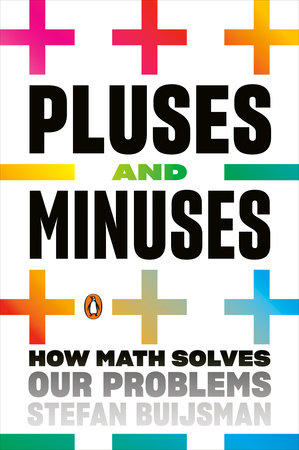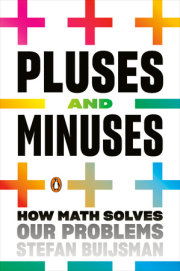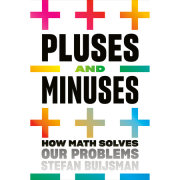IntroductionLet’s go back in time. I’m looking at my maths teacher with a glazed expression. On a digital blackboard there is a series of formulas and a drawing of a wavy line touched by a number of straight lines. Like everyone else doing maths in their final years at secondary school, I have to learn what these formulas and drawings mean. Why? In my case because I want to study astronomy. What I don’t know yet is that I’m far too impatient to be any good at that. But what if I had known? And known that in the profession I ended up in I hardly ever need to make calculations? Then I would have entered the following question into Google: what is maths good for?
The first result that Google comes up with is an article from a Dutch daily newspaper on Pythagoras’ theorem and how to cut up pizzas. Wonderfully concrete, but it only illustrates a very small part of the usefulness of mathematics. Without maths I wouldn’t even have been able to look for an answer to my question in Google. Or I would have ended up with an article that had nothing to do with my question. A search engine like Google can only work by using mathematics. And I don’t just mean that computers work with ones and zeros: Google uses a clever piece of maths to find a relevant answer to my question. Before Google’s founders, Sergey Brin and Larry Page, devised this method in 1998, the first hit for anyone who entered, for example, ‘Bill Clinton’ into the search field would have been a photograph of him together with the joke of the day. If you searched for ‘Yahoo’ in Yahoo, the search engine itself didn’t even appear in the top ten hits! Luckily, that no longer happens – and we have maths to thank for it.
And yet a lot of people today still have the same feeling I had at secondary school. To them maths is a blackboard full of formulas that you can barely understand and will never need after you’ve left school. No wonder it seems incomprehensible and useless to so many people. But the opposite is true: mathematics plays a very important part in our modern society and, for anyone who looks beyond the formulas, it’s easier to understand than we often think. The way Google chooses information for us shows how much maths influences our everyday lives, both positively and negatively. Digital services like Google, Facebook and Twitter can reinforce existing opinions and beliefs. Today we are constantly confronted with fake news, which is very difficult to prevent. That’s partly because of the way these services work. We can only learn how to combat fake news if we understand how internet services strengthen our opinions and why it’s not easy to change the way they do that.
In this book, I want to show how useful mathematics is. In a certain sense, now that I understand maths better, it’s aimed at my younger self. But it’s also aimed at all those people who think, like I used to, that mathematical calculations are difficult and irrelevant and are happy that they don’t have anything to do with them. Since I’ve been working as a philosopher of mathematics and think a lot about how maths works and how we learn about it, I know that it is extremely relevant to all of us, whether we have to use it in our work or not. Mathematics is about much more than formulas, which is why there are so few of them in this book. They’re useful if you want to figure out a specific problem, but they often distract from the ideas behind the maths.
In this book, in order to show that mathematics is more relevant and understandable than a lot of people think, I look at various areas of maths and the ideas behind them. These areas have surprisingly many applications which everyone can easily understand, especially if we forget about the formulas. Take graph theory: search engines like Google use graph theory to order search results, but it’s also used to predict how cancer patients will react to a certain treatment and to study traffic flows in large cities.
The same applies to the other areas of modern mathematics that I examine in this book: statistics and calculus. The ideas behind them are often unexpectedly simple and much more useful than you might suspect from what you learned at school. We come across statistics in the news almost every day, in the form of figures on crime, the economy, politics, and so on. Often, it’s not clear what the figures actually mean and where they come from. People were already warning about the dangers of misleading statistics a century ago, with good reason. And those warnings have become even more important today.
Like graph theory, calculus is useful because it makes all kinds of applications possible without our noticing it. Since the Industrial Revolution it has been used to improve the efficiency of steam engines, allow cars to drive themselves, build skyscrapers and much more. If an area of maths has changed history, it’s calculus.
But before I discuss the many modern applications of mathematics in greater detail, we have to go back to its very first beginnings. That doesn’t mean searching for complex historical sums or ancient scholars, but looking at the history of mankind itself. Each of us is born with a wide range of mathematical skills, with which we can survive even without maths lessons. However, history shows us that these inborn skills fall short when people live in large groups. At a certain point, societies simply get too big to function without maths and we have to turn our attention to arithmetic and geometry. Some cultures still manage to survive without any form of maths, but they are always small societies that, for example, don’t build towns and cities. The abstraction of mathematics is necessary for things like organising a community, for security, to construct houses and other buildings, to regulate the supply of food, etc. Maths makes practical problems simpler and the world around us more manageable.
The question about what maths is good for isn’t only about mathematics in practice but is, in the first instance, philosophical. That’s why I begin and end this book with a detour to philosophy. Philosophers of mathematics have been asking themselves for centuries what maths is and how it works, without concerning themselves too much with sums and formulas. Some of those questions still haven’t been answered, but the philosophy of mathematics has come far enough for us to know what the right answers will look like.
Yet, as with most philosophical questions, you’ll have to decide for yourself what you think about maths and which answers appeal to you most. And whether you’re happy with how mathematics is used today. Do the advantages of Facebook, for example, outweigh the disadvantages? I leave it to you to answer that question for yourself. In the meantime, I’ll try to explain what part maths plays in applications like Facebook, why they have the disadvantages that we are all now familiar with, and why those disadvantages can’t be solved by simply changing the mathematical idea behind them.
1. Maths all around us Every time you use Google Maps to find the way somewhere, you rely on a piece of mathematics. You open the app, enter your destination and, within a few seconds, it will automatically come up with a few possible routes. Google can only do that through clever use of maths.
Imagine that Google was crazy enough to get people who are good at reading maps to work out your route. Every time you searched for a route, they would put those people to work. Not only would that take a very long time, but it would also be very inefficient. Google’s map-readers would repeatedly have to work out the same route for people like me who can’t remember how long it takes to get from home to their friends’ houses. Preferably, they would work out all kinds of routes in advance, just in case someone might need them one day.
But would that be any better? The chances that someone else needs exactly the same route as you aren’t that great unless, for example, you live in a student house and are looking for the best route to the university. And my neighbours certainly won’t be visiting my friends or my publisher, whom I look up in the app because I want to make sure yet again that I’ll get there on time. Unless Google can predict what journeys I’m going to be making, it is regularly going to need someone to work out new routes. And, let’s face it, no matter how good they are with a map, that takes a lot of time
That’s why we leave the map-reading to maths. A computer works out the best way for you to make your journey, but not in the same way that people do. The maths that a computer uses doesn’t
recognise streets on a satellite photo and can’t calculate distances from the scale of a map.
Navigation systems see the world as a collection of small circles joined together by lines. Strange as that may sound, it will be familiar to anyone who has seen a map of an underground train system, like the map of the London Underground below.
Copyright © 2020 by Stefan Buijsman. All rights reserved. No part of this excerpt may be reproduced or reprinted without permission in writing from the publisher.








